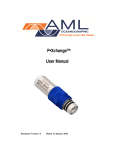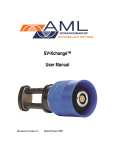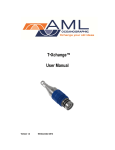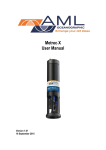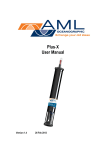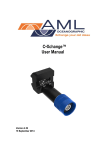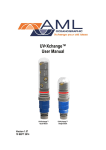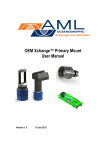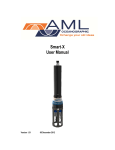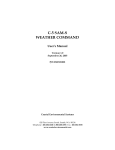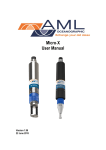Download Turbidity•Xchange - User Manual
Transcript
Turbidity•Xchange™ User Manual Version 1.3 06 March 2013 User Manual for AML Oceanographic’s Turbidity•Xchange™ Revision Date Description Author Version 1.3 06 March 2013 Updated Sensor Specifications Dustin Olender 1 User Manual for AML Oceanographic’s Turbidity•Xchange™ Table of Contents General Description of the Sensor ............................................................................................................ 3 Which Manual do I Start With?.................................................................................................................. 3 Shipping and Receiving ............................................................................................................................ 4 Receiving the Sensor ........................................................................................................................... 4 Shipping the Sensor ............................................................................................................................. 4 Using Turbidity•Xchange™ ....................................................................................................................... 5 Pressure Ratings.................................................................................................................................. 5 Attaching the Turbidity•Xchange™ Sensor .......................................................................................... 5 Removing the Turbidity•Xchange™ Sensor ......................................................................................... 6 Pre-Deployment Procedures ................................................................................................................ 7 Post-Deployment Procedures .............................................................................................................. 7 Periodic Maintenance........................................................................................................................... 7 Inspecting & Replacing the O-ring........................................................................................................ 8 Turbidity•Xchange™ Commands .............................................................................................................. 9 Talking to the Turbidity•Xchange™ Sensor.......................................................................................... 9 Specific Commands of Interest ............................................................................................................ 9 Customer Support ................................................................................................................................... 10 Troubleshooting ................................................................................................................................. 10 AML Oceanographic Contact Info ...................................................................................................... 11 Technical Specifications ......................................................................................................................... 12 Sensors .............................................................................................................................................. 12 Mechanical Materials ......................................................................................................................... 12 Sampling Capabilities......................................................................................................................... 12 2 User Manual for AML Oceanographic’s Turbidity•Xchange™ General Description of the Sensor The AML Oceanographic’s Turbidity•Xchange™ sensor is the industry’s only field swappable turbidity sensor. The Turbidity•Xchange™ sensors store all pertinent sensor manufacturing and calibration data within the sensor. This allows the sensor to be swapped between any Turbidity•Xchange™ enabled instruments without having to manually update the calibration coefficients. Calibration sheets can be printed on demand by any instrument connected to the SeaCast software. Recalibrations only require the sensor, not the instrument, to be shipped to the service centre. Turbidity•Xchange™ sensors are engraved at the factory with a unique serial number and the turbidity range of the sensor as shown in the image below. Turbidity Range Serial Number Turbidity•Xchange™ Engraving Which Manual do I Start With? AML Oceanographic’s sensors and instruments may be shipped with several manuals: • • • An instrument manual (I.e. SV Plus v2, Minos•X) which provides an overview on how to use and maintain the instrument; A software manual (I.e. SeaCast) which provides instructions on how to use the software to configure the instrument and review instrument data; and An Xchange™ manual (for instruments equipped with Xchange™ sensors) which provides an overview on how to install and maintain Xchange™ sensors. If you are configuring an instrument for field use or lab test, we recommend that you begin with the SeaCast manual. If you are focussed on instrument maintenance, we recommend that you begin with the instrument manual. If you are wishing to swap a Turbidity•Xchange™ sensor, we recommend that you read this manual. 3 User Manual for AML Oceanographic’s Turbidity•Xchange™ Shipping and Receiving Receiving the Sensor When the sensor is received at a new location it is prudent to perform the following steps to ensure the sensor has not been damaged in transit: • • • • Check the shipping container for signs of damage Check for damage on the sensor itself o Check the sensor for dents or dirt. o Check the connector for corrosion or dirt Connect the sensor to an instrument. Connect the instrument to a computer using the data cable. Launch SeaCast, AML Oceanographic’s application software. Verify that the instrument tab in SeaCast is displaying accurate Turbidity•Xchange™ sensor information. The Turbidity•Xchange™ sensor serial number and last calibration date should be displayed. On the View Data page select Monitor and allow the instrument to sample some data, as shown below. This will confirm the sensor is working. Shipping the Sensor • • If shipping for repair or recalibration, obtain an RMA number from the service centre. Please refer to page 10 for contact details. Pack the instrument in its original shipping box to prevent damage during shipping. 4 User Manual for AML Oceanographic’s Turbidity•Xchange™ Using Turbidity•Xchange™ This section of the manual discusses how to attach and disconnect the Turbidity•Xchange™ sensor. This section also identifies pre-deployment and post-deployment procedures, as well as periodic maintenance requirements. Pressure Ratings The Turbidity•Xchange™ sensor is rated to operate to a maximum depth of 500 m. However, the instrument the Turbidity•Xchange™ sensor is used on and its additional installed sensors will all have their own depth ratings. Deployments should never exceed the shallower of these pressure limitations. Attaching the Turbidity•Xchange™ Sensor • • • • • • • Select a Turbidity•Xchange™ turbidity range that is compatible with your deployment. Ensure that the instrument socket is clean and dry Check the sensor’s o-ring for cleanliness (see below, Inspecting & Replacing O-Rings) Align the sensor to the sensor mount Place the sensor into the mount Rotate the sensor until it drops down into the mount enough to allow the blue collar threads to engage the mount threads Screw down the blue collar until it stops. The bottom of the collar should be within 1 mm of the instrument end cap 5 User Manual for AML Oceanographic’s Turbidity•Xchange™ Removing the Turbidity•Xchange™ Sensor • • • • • • If the sensor has been used in salt water rinse it in fresh water. Dry the sensor before removal to protect the connector. Unscrew the blue collar. Lift the sensor out of the mount. Ensure that the instrument socket is dry and clean, using compressed air if necessary. Immediately insert the blanking plug in the Turbidity•Xchange™ socket on the end-cap OR insert a replacement Turbidity•Xchange™ sensor Turbidity•Xchange™ Blanking Plug 6 User Manual for AML Oceanographic’s Turbidity•Xchange™ Pre-Deployment Procedures • • 4 to 6 weeks ahead o Ensure that the installed Turbidity•Xchange™ sensor has the correct turbidity range for the deployment. If necessary, swap with another calibrated Turbidity•Xchange™ sensor with the correct range. o Use the receiving checklist to verify the sensor is in good working order. o Verify the calibration is valid for the duration of the deployment. Have the sensor re-calibrated if required or swap with another calibrated Turbidity•Xchange™ sensor. Before leaving the jetty o Ensure the Turbidity•Xchange™ sensor is properly mounted on the instrument. The blue locking collar should be fully threaded onto the sensor mount of the instrument. o Test the instrument to ensure the Turbidity•Xchange™ sensor is functioning properly. Post-Deployment Procedures • Ensure the sensor is clean and dry before storage Periodic Maintenance Periodic maintenance will prolong the life of the sensor. The following is recommended: • • • • • • • If the sensor is dirty or oily, leave the sensor on the instrument. Prepare some warm soapy water and allow the instrument to soak before cleaning with a rag or soft brush. Rinse with fresh water. Before each deployment o Check the sensor is properly seated on the instrument o Check the sensor for cleanliness or damage After each deployment o Clean and rinse the sensor using fresh water Before installing on an instrument o Check the sensor for cleanliness or damage o Check the o-ring under the blue locking collar of the sensor for cleanliness and silicon grease Removing from an instrument o Ensure the sensor is clean and dry before removing o Install a new sensor or blanking plug into the instrument to protect the contacts of the sensor mount o Safely store the sensor Yearly o Send the sensor to a service centre for diagnostics and re-calibration Long term storage preparation o Ensure the instrument has been thoroughly cleaned and dried. o Remove all Xchange sensors from the instrument and dry the connectors. o Lubricate the instrument and Xchange sensor connector contacts with a silicone spray. o Lubricate the retainer rings and o-rings with silicone grease. o Install connector and sensor blanking plugs in the instrument. 7 User Manual for AML Oceanographic’s Turbidity•Xchange™ Inspecting & Replacing the O-ring It is crucial to keep the Turbidity•Xchange™ sensor’s o-rings clean and greased. Any fibres or dirt on or around the o-rings and grooves will allow water into the connector and damage both the sensor and the sensor mount. To gain access to the o-rings, perform the following steps: • • • • Remove the sensor from the instrument The o-rings should be slick with grease. If the o-rings are dry, apply silicone grease. Inspect the o-rings for dirt. Clean and reapply grease if necessary Inspect the o-rings for nicks and cracks. If any are found the o-rings must be replaced. Use 2-015-N70D Buna Nitrile o-rings. Apply silicone grease to the o-rings before replacing. Caution: Do not use a sharp instrument to remove the o-rings. If the o-ring grooves are scratched, the o-rings will not provide a waterproof seal. The o-rings can be removed easily with bare hands as shown below. O-rings O-ring Removal 8 User Manual for AML Oceanographic’s Turbidity•Xchange™ Turbidity•Xchange™ Commands When using AML Oceanographic’s SeaCast application software, knowledge of the instrument command set is not usually necessary. However, the operator can issue text commands to the instrument as well as to specific sensors on an instrument. This can be done from SeaCast or any terminal emulation program such as HyperTerminal. There is additional functionality on Turbidity•Xchange™ equipped instruments with respect to the command set. To use these commands, the user must first establish direct communication with the Turbidity•Xchange™ sensor. Talking to the Turbidity•Xchange™ Sensor There are two ways to accomplish direct communication with the Turbidity•Xchange™ sensor. They are: 1. On a Micro X instrument with the Turbidity•Xchange™ option, the Turbidity•Xchange™ commands can be given directly to the instrument. Simply type the commands into the terminal emulation program. 2. On a Smart.X, Minos.X or Plus.X instrument, the “TALK” command is used to direct communications to the Turbidity•Xchange™ sensor. Use the following procedure to accomplish this: Entering Talk Mode o Establish communications with the instrument o Send a “DETECT” command to the instrument. The instrument will return a list of sensors detected on each slot of the instrument. Note the slot number for the Turbidity•Xchange™ sensor. o Send a “TALK 2” command to the instrument. Replace the 2 with the appropriate slot number if required. This command directs subsequent communications directly to the sensor board. Exiting Talk Mode o To exit talk mode, simultaneously press the CTRL and C keys Specific Commands of Interest • • DIS OPTIONS DIS TURB CAL Displays the current settings for the Turbidity•Xchange™ Displays the calibration coefficients for the sensor 9 User Manual for AML Oceanographic’s Turbidity•Xchange™ Customer Support Troubleshooting Instrument fails to detect the sensor • Is the sensor properly mounted on the instrument? o Is the sensor fully screwed down? o Check the connector on both the sensor and the instrument for corrosion or damaged contacts. o Cycle the instrument power. • Call the nearest service center for support Turbidity sensor is noisy • Check the connector on both the sensor and the instrument for corrosion or damaged contacts • Is the instrument subject to vibrations? • Are there turbidity eddies in the water being tested? • Is there a nearby source of electromagnetic interference? Examples are arcing brushes on electric motors, radio transmitters, switching power supplies, and faulty cathode ray tube monitors. • Check the power supply to the sensor for noise. Ideally the power supply should have less than 30mV of noise. Turbidity sensor is inaccurate • Is debris blocking sensor face? • Is sensor face within 20mm of a surface or object? • Is number format, i.e. number of digits in front and behind decimal place, correct? Turbidity sensor does not fit on instrument • Turbidity•Xchange is not mechanically compatible with Smart•X SeaCast fails to recognize a sensor: • Be sure to download the latest version of SeaCast o Turbidity•Xchange™ requires SeaCast version 3.0 or greater for full functionality 10 User Manual for AML Oceanographic’s Turbidity•Xchange™ AML Oceanographic Contact Info Service: To request an RMA or technical support Email: service@ AMLoceanographic.com Phone: 1-250-656-0771 Fax: 1-250-655-3655 Sales: For all general sales inquiries Email: sales@ AMLoceanographic.com Phone: 1-250-656-0771 Fax: 1-250-655-3655 Website: http://www. AMLoceanographic.com Customer Portal: The Customer Portal allows AML Oceanographic customers to download calibration certificates and other related instrument/sensor documentation, view instrument/sensor details and diagnostic reports. It also allows AML Oceanographic customers to gather technical documentation, troubleshooting guides etc. RMA requests or technical support queries may also be submitted through the portal. To access the Customer Portal, please navigate to the ‘Support’ button, located on the top right hand side of AML Oceanographic home page, select the ‘Customer Centre’ from the options on the drop down menu and follow the instructions provided. Mailing and Shipping Address: AML Oceanographic Ltd. 2071 Malaview Ave. Sidney, BC, Canada V8L 5X6 11 User Manual for AML Oceanographic’s Turbidity•Xchange™ Technical Specifications Sensors Type Range Turbidity•Xchange™ Turbidity Sensors Accuracy Precision Resolution 0 to 100 NTU ±1% or 0.1* ±0.1 NTU 0.01 NTU Response Time <0.7 s Turbidity•Xchange™ 0 to 400 NTU ±1% or 0.2* ±0.2 NTU 0.01 NTU <0.7 s Turbidity•Xchange™ 0 to 1000 NTU ±2% or 0.5* ±0.5 NTU 0.1 NTU <0.7 s Turbidity•Xchange™ 0 to 3000 NTU ±5% or 1.0* ±1 NTU 0.1 NTU <0.7 s Mechanical Materials Housing Status Type Depth Rating Diameter Length Standard Titanium 500m 28.7mm (1.13”) 133.4mm (5.25”) Sampling Capabilities • Samples up to 25 times per second (25 Hz) 12













